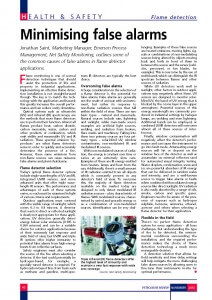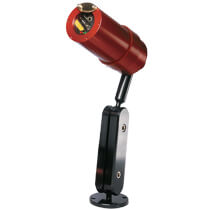Process manufacturers with hazardous areas in their process are responsible for the safety of the process through the IEC 61511 safety lifecycle—from initial design through decommissioning.

 Flame monitoring is often an important component in risk mitigation. Emerson’s Jonathan Saint wrote a Petroleum Review article, Minimising false alarms, to address this major challenge with flame detection systems. Jonathan stresses the importance of selecting the right flame-detection technology with your application and provides some important considerations in the article.
Flame monitoring is often an important component in risk mitigation. Emerson’s Jonathan Saint wrote a Petroleum Review article, Minimising false alarms, to address this major challenge with flame detection systems. Jonathan stresses the importance of selecting the right flame-detection technology with your application and provides some important considerations in the article.
He opens describing key flame detection technologies:
Optical systems such as ultraviolet (UV) and infrared (IR) spectroscopy are the methods that most flame detectors use to perform their function. Almost all flames produce heat, carbon dioxide, carbon monoxide, water, carbon and other products of combustion, which emit visible and measurable UV and IR radiation.
The issue is when non-flame sources trip the sensors to produce false alarms. Jonathan highlights several application examples. For flame detection in outdoor applications, the flame detector technology:
…must contend with the visible range of sunlight, which covers 0.3 to 0.8 microns. A detector that reacts to direct or reflected sunlight is clearly not appropriate for these applications. UV detectors generally detect energy below solar emissions (0.185 to 0.026 microns) and can be a suitable choice for outdoor applications because of their extremely fast response and wide field of view; but UV/IR and triple IR options offer higher immunity to potential false alarms from high-energy bursts from reflective surfaces.
 The fuel for the fire is another consideration. A hydrogen-fueled flame requires a specially tuned detector while hydrocarbon-fueled fires:
The fuel for the fire is another consideration. A hydrogen-fueled flame requires a specially tuned detector while hydrocarbon-fueled fires:
…such as methane and gasoline, multi-spectrum IR detectors are typically the best choice.
Jonathan explains that the flame detection equipment does typically not cause false alarms but rather:
…non-flame radiation sources that fall within the field of view. There are two basic types – natural and man-made. Natural sources include rain, lightning and sunlight, while man-made source examples are artificial light sources, welding, and radiation from heaters, flare stacks and machinery.
From these sources, he describes four types of non-flame radiation sources—solar-blind UV, detector window contaminants, non-modulated IR and modulated IR sources. Non-modulated sources provide constant or slowly varying radiant energy over time and include sources such as heaters, lamps, and heat from sunlight. Most flame detectors are designed to detect modulated or changing IR since this is a key characteristic in flames.
False alarms can occur from sources such as:
…heated emissions, moving lights, signals or combinations of non-modulating sources being altered by objects moving back and forth in front of them in between the source and the sensor (vehicles, personnel, or fan blades for example).
Multi-band flame detectors can help overcome false alarms from these non-flame sources.
Solar-blind UV is the part of the UV energy blocked by the Earth’s ozone layer. This band is where UV sensors look for flames. Non-flame sources can include:
…halogen lamps, arc welding and even lightning.
Using additional bands or combined UV/IR detectors can overcome these false alarm sources.
Window contaminants can occur from water droplets, condensation, snow, ice, oils, smoke, carbon, and process-specific gases. Automated Visual Integrity tests and manual VI test can be performed as part of the safety management process.
Jonathan closes stressing there is no perfect flame detection system for every application.
But understanding the type of fire to be detected, the environmental conditions surrounding the installation, and the required performance makes the choice of the flame detection technology a much more manageable decision.
You can connect and interact with Jonathan and the flame detection system experts in the Emerson Exchange 365 Analytical and Safety Instrumented System tracks.




